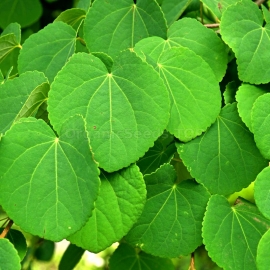



Katsura Tree Seeds (Cercidiphyllum japonicum)
1.39 €
A deciduous tree native to China and Japan, it is overall an oval-canopied tree but some specimens can become quite widely spreading with sprawling branches. Its gray-brown bark exfoliates in vertical bands, adding winter and spring interest.
-
Katsura Tree / Cercidiphyllum japonicum
Kindly regarded as one of the world's most beautiful and modest of shade trees, the katsura tree has elegant heart-shaped leaves, red fall foliage and persistent coppery-tan seedpods that decorate the bare winter branches.
A deciduous tree native to China and Japan, it is overall an oval-canopied tree but some specimens can become quite widely spreading with sprawling branches. Its gray-brown bark exfoliates in vertical bands, adding winter and spring interest.
The heart-shaped leaves first emerge bronzed before becoming a modest green. Each leaf blade has tiny scalloped edges and are usually held in opposite pairs on the branches. In early spring before leaves emerge, flowers adorn thsi dioecious species - red female flowers occur on a separate tree than those of the green male blossoms. The female tree yields many small green pods that ripen to a coppery tan and split open to shed the winged seeds. In autumn the foliage becomes a lovely mottled kaleidoscope of yellow, orange-red and dark red. The dropping leaves emit a sweet fragrance that is lightly honey- or sugar-scented.
Grow katsura tree in full or partial sun in a fertile, deep, moist but well-draining soil. Avoid highly alkaline soils and position this tree in a spot protected from drying cold winter winds (thus a tree not always favorable for the American Midwest). It needs ample moisture to establish when young; it does not transplant well. Use this often multi-stemmed or wide-branched tree as a specimen park, cemetery or campus shade tree. It may be a street tree only if it has rich soil and ample room.
How to Grow
Seed - best sown as soon as it is ripe in a cold frame. Sow stored seed in a greenhouse in late winter. When they are large enough to handle, prick the seedlings out into individual pots and grow them on in a greenhouse for at least their first winter. Plant them out into their permanent positions in late spring or early summer, after the last expected frosts. Layering in autumn. Takes 12 months. High percentage. Basal cuttings, 15cm long, taken from May to July. Harvest the shoots with plenty of underground stem. Pot them up into individual pots and keep them in light shade in a cold frame or greenhouse until they are rooting well. Plant them out in the summer.
